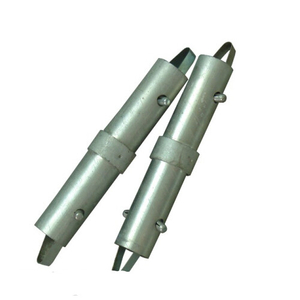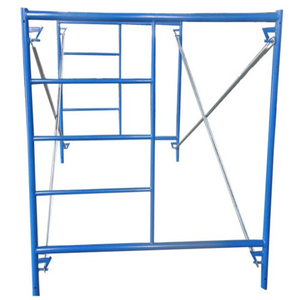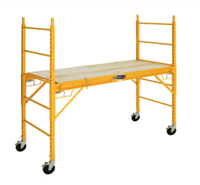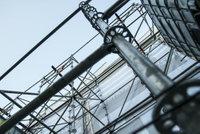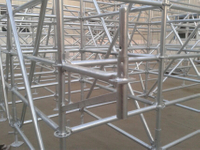Because Mason frame scaffolding is versatile and economical, it is considered to be the most common type of bracket. However, there are still many people who do not understand Mason scaffolding. Many people will ask: What are the main components of the masonry scaffolding? How do we use it?
What is a mason frame scaffolding?
Basic scaffolding elements
How to use mason scaffolding?
Conclusion
What is a mason frame scaffolding?
Mason scaffolding or mason frame scaffolding is a common industry term referring to our popular Frame and Brace scaffolding. This is the most common type of scaffolding used by all types of contractors, making bricks or blocks safer and more efficient, from carpenters and masons to homeowners of his weekend projects. It is easy to set up and disassemble, allowing you to reach the desired height quickly.
They are often used by residential contractors, painters, etc. for one or two floors, but their modular frames can also be stacked several times for large construction work.
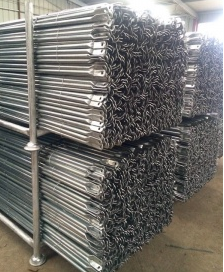
Basic scaffolding elements
The basic scaffolding elements include three common components: standard, ledger and beam. A standard is that the mass of the bracket is directly connected to the long tube or tube of the ground and the length of the scaffold it operates. Each standard base is attached to the base plate, which helps to distribute the weight of each standard bear. Between each standard operating horizontally is a ledger that adds further support and weight distribution. Beams placed at the top of the ledger at right angles come in several different forms. The main beam supports the standard by attaching the standard to the support and support plates. The intermediate beam is placed with the main beam to provide additional plate support.
In addition to standards, ledgers and beams, there are other supporting elements that can be used to enhance basic scaffolding. Parentheses, such as ribs, ivory braces, and additional couplers, can be used in different combinations to support multiple ways of structure. The cross brackets run diagonally between the ledgers and are securely attached to the standard to increase the overall rigidity of the structure. However, it can also fix itself on the ledger, in which case they are simply referred to as ledgers. The outer wall support helps prevent structural rocking and adheres to the surface of the scaffolding, extending along the surface of the structure and firmly attached to each level.
Couplers help to connect structural elements and have a variety of variants. To connect the ledger or beam to the standard, a right angle coupler should be used. If the beam supports the board and must be connected to the ledger, the ledger should be connected to the beam using a putlog or single coupler. Rotating joints are recommended for any other connection angle between the scaffolding pipes.
The length, width and height of each scaffolding component can vary from building to building, but there are several basic measurements for each basic component. The general width of the stent is typically determined by the width of the stent panel. The height between the ledgers, also known as the lift height, is usually between 2 and 2.7 meters. Beam placement depends on board thickness. If the board has a thickness of 38 mm, the beams should be at most 1.2 m apart. A 50 mm thick board requires beams to be no more than 2.6 meters apart.
In addition to the basic structural elements of the scaffolding, there are a variety of ties that secure the scaffolding to adjacent buildings. As a general rule, connect every 4 meters at alternate lift levels. However, the type of lacing and the type of lacing used may vary depending on the type of stent. For example, by connecting, the scaffolding can be secured to the building by entering an open window of the building. The box ties help to secure the scaffolding by connecting to external features of the building, such as strong columns.
How to use mason scaffolding?
The erection and use of scaffolding requires planning and careful implementation to ensure safe and efficient work. Here are some steps to help you understand how to complete.
1.Plan the scaffolding project to provide sufficient material for the work. If you can use it for many projects, you can rent or buy scaffolding. The basic parts of the scaffolding system include the following items:Scaffolding jacks, stacking pins, leveling legs or bottom plates, harnesses, ladders, scaffolding boards, legs, various clamps and pins for assembly.
2. Items required to rent or purchase a project. There are many professional rental companies that design and even assemble and disassemble scaffolding for engineering. Having skilled workers erecting scaffolding is critical to safety and productivity, not to mention avoiding possible fines from security agencies such as OSHA (US) or similar safety regulators.
3. Prepare the area where the scaffolding will be erected. It should erect the ground or surface as flat as possible, the soil should be compacted and have sufficient drainage to support the scaffolding, even in wet weather.
4. Arrange the jacks according to the manufacturer's spacing and use adjustable support legs to ensure the first lifting level and vertical of the jack. Proper installation of the first scaffolding will make the scaffold easier and ensure that the finished scaffolding system provides a safe, stable working platform upon completion.
5. Install all supports and connectors before proceeding to the next level jack. Ladders should be provided to access each scaffolding layer and workers should be provided with personal safety equipment such as gloves, safety glasses and fall arresters during the installation process.
6. Use the scaffolding board to lay each level of scaffolding before installing the next level. You may find that you can install a minimum number of plates of scaffolding jacks at each level, but since normal brick work will be performed from each level, having a complete deck will make stock material and enter the work area. Safe and easier.
7. Install safety functions as soon as possible on each scaffolding structure level. Handrails, toe boards and access doors should be installed and materials placed on the scaffolding deck before allowing workers to work without fall protection.
8. Bind the high scaffolding structure to the adjacent structure to prevent the scaffold from falling. Depending on your location and work, government regulations may require support or support for scaffold prior to use. In the United States, OSHA requires this support when the scaffold has an aspect ratio of 4 to 1 or greater. For example, if the height is 20 feet (6.09 meters) or higher, a 5 foot (1.5 meter) wide scaffolding must be secured.
9. Is it responsible for supervising the installation and use of the scaffolding (this is a qualified person according to the OSHA guidelines) to check the scaffold before use. Labels should be posted at the access location and should contain a daily check log of daily signatures and dates.
10. Install the legs and other accessories needed for the necessary work when needed. This will allow workers to adjust the height of work between each level and enable them to work more efficiently.
11. Stock materials used for scaffold from the scaffolding deck. Large projects and projects that load large amounts of material at regular intervals should install a channel tower on the main scaffolding system so that the weight of these materials is not dangerous and the worker's access deck can be maintained on the scaffold. Avoid overloading the scaffolding deck. As a rule of thumb, scaffolding boards can sag more than an inch (2.5 cm) at any time and they may be overloaded.
12. Perform scaffolding work, whether it is laying bricks or blocks, installing insulation, waterproofing or plastering, painting and/or caulking.
13. Remove the scaffolding when the work is completed. This is usually done in the reverse order of assembly and care should be taken to manage all materials so that they can be safely lowered to the ground. Cleaning loose debris and using buckets or bags to hold small parts will help prevent items from falling to areas that may be damaged or lost, or workers may be injured.
14. Clean up the area where scaffolding is used and store the scaffold until needed again. The rented scaffold should be calculated and returned to the rental company and any damaged or missing items reported.
Conclusion
It is undeniable that Mason Frame Scaffolding is safe, economical and easy to use, but more importantly, you need to choose a standard Mason Frame Scaffolding and know how to use it correctly. If you are looking for a bricklayer skeleton scaffolding with reasonable price and high quality, Nanjing Tuopeng Construction Technology can provide you with perfect products.










